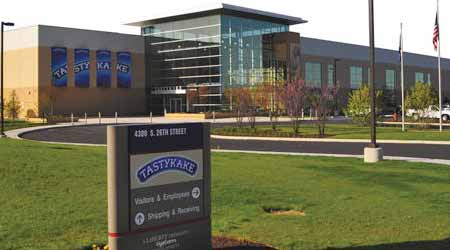 The more efficient LEED Silver 345,000-square-foot manufacturing facility in Philadelphia for Tasty Baking Co. produces more in a small space than the company’s previous facility.
The more efficient LEED Silver 345,000-square-foot manufacturing facility in Philadelphia for Tasty Baking Co. produces more in a small space than the company’s previous facility. USGBC Perspective: A Look at the Green Industrial Sector
Third part of a three-part Green Building Report.
Born from the Industrial Revolution, the manufacturing sector has a rich history as a global economic driver that has spurred innovation and technological advances to solve the problems of the day — a reality that remains today. While manufacturing often conjures up images of smokestacks and environmental pollution, the modern sector looks nothing like it did at its inception. Through the use of LEED, manufacturing facilities are prioritizing the triple bottom line of people, planet, and profit, according to the new LEED in Motion Report: Industrial Facilities report from the U.S. Green Building Council (USGBC).
Industrial facilities are responsible for 30 percent of the nation’s total energy consumption and use an estimated 15,900 million gallons of water per day, roughly 4 percent of total daily water use. Yet while the opportunity for savings and efficiencies for industrial facilities is great, manufacturing spaces are vastly more complex than an average commercial office space. In 2012, USGBC saw the opportunity to meet these complex needs and invited companies from across the manufacturing sector to join the LEED User Group: Industrial Facilities. Through the implementation of the user group, USGBC and industry stakeholders were able to collaborate, share best practices, and ensure that LEED met the unique design, operations, and maintenance requirements of industrial facilities.
Today, there are more than 1,755 LEED-certified industrial facilities globally, comprising more than 496 million square feet. And that number is expected to increase significantly: there are currently more than 2,710 registered industrial facilities totaling nearly 737 million square feet. Through the pursuit of LEED certification, these buildings are more resource-efficient and high-performing, which translates to increased asset value and millions of dollars in savings for owners and operators.
The manufacturing sector is also a significant economic driver worldwide, providing not only direct employment but also a ripple effect of commerce throughout the region. In the United States alone, the manufacturing industry contributed $2.1 trillion in gross domestic product (GDP) in 2014 and, according to the National Association of Manufacturers, for every $1 spent in manufacturing, an additional $1.40 is added to the economy. The sector also provides 12.33 million jobs and indirectly supports an additional 18.5 million U.S. jobs. USGBC’s recent Green Building Economic Impact Study found that across industries, green construction jobs are poised to create more than 3.3 million U.S. jobs and $190.3 billion in labor earnings by 2018.
From local to global, LEED certification goes beyond energy and costs savings to positively impact occupant health and safety. Employees at the Tasty Baking Co. in Philadelphia, Penn., know the benefits of LEED firsthand. The state-of-the-art 345,000-square-foot manufacturing facility, certified to LEED Silver, features a white roof to help reduce the heat island effect of the property, and native, drought-resistant landscaping to reduce water consumption and storm water runoff. When it opened in 2010, the building’s efficient design also allowed Tasty to produce more in a smaller space than its previous bakery – helping reduce energy and water costs while also increasing output.
The Colgate-Palmolive facility in Swidnica, Poland, recently expanded their facility and certified to LEED Gold, resulting in more than 50 percent water use reduction and energy costs savings of more than 20 percent. In addition, more than 22 percent of the total building material content was manufactured using recycled materials.
Tasty Baking Co. and Colgate-Palmolive are just two examples of manufacturing companies tying business sustainably to environmental sustainably and continuing the innovation and technological advancement on which the manufacturing sector was founded. To learn more about LEED for industrial facilities and how international brands are implementing green practices, read USGBC’s LEED in Motion: Industrial Facilities report here.
Related Topics:














